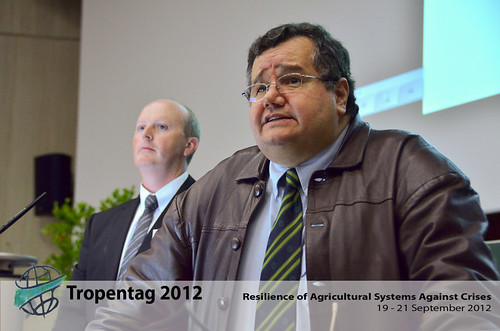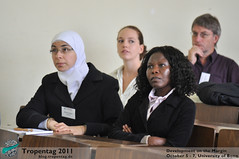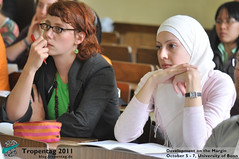food security
Hans H. Ruthenberg Award for Graduates 2012 winners speak about their research
Thu, 09/20/2012 - 10:54 — De-Registered User
Once again the fiat panis award winners were felicitated during the Tropentag 2012 conference. There were two awards in total, the Hans H. Ruthenberg Award for Graduates 2012 for master level students and the Josef G. Knoll European Science Award 2012 for PhD students.
The following are the winners of the Hans H. Ruthenberg Award for Graduates 2012:
Lilli Scheiterle from University of Hohenheim spoke about her research work in Ghana. She carried out research on the topic “Opportunities and Challenges in the Production of Maize in Northern Ghana”.
 Lilli Scheiterle
Reginald Tang Guuroh from Ghana, doing his PhD in University of Bonn at present spoke on his research topic “Contribution of Home Gardens to Household Income Generation in Burkina Faso- A Case study of Bieha District”.
Lilli Scheiterle
Reginald Tang Guuroh from Ghana, doing his PhD in University of Bonn at present spoke on his research topic “Contribution of Home Gardens to Household Income Generation in Burkina Faso- A Case study of Bieha District”.
 Reginald Tang Guuroh
Reginald Tang Guuroh
 Lilli Scheiterle
Reginald Tang Guuroh from Ghana, doing his PhD in University of Bonn at present spoke on his research topic “Contribution of Home Gardens to Household Income Generation in Burkina Faso- A Case study of Bieha District”.
Lilli Scheiterle
Reginald Tang Guuroh from Ghana, doing his PhD in University of Bonn at present spoke on his research topic “Contribution of Home Gardens to Household Income Generation in Burkina Faso- A Case study of Bieha District”.
 Reginald Tang Guuroh
Reginald Tang Guuroh
More Potatoes- Is Genetic Enhancement the answer?
Thu, 09/20/2012 - 08:51 — De-Registered User
Prof. Rodomiro Ortiz spoke about the role of "Agrobiodiversity Management for Food Security" in one of the plenary sessions of Tropentag 2012. He is presently Faculty Professor, Department of Plant Breeding and Biotechnology, Swedish University of Agricultural Sciences, Sweden.
 His presentation dealt about World´s food, Agrobiodiversity, Green Revolution, Climate change and Biotechnology tools.
The global food crisis is a major concern in today’s world. There is an annual increase of 78 million population in the world. More than 1.5 billion people are suffering from obesity worldwide while more than one billion people are under poverty and around three billion people are under/ nourished. 30% of all food crops worldwide are wasted.
The main challenge today related to global crisis is “the world continues facing an increasing demand for nutritious and quality food, feed, fiber and fuel”.
“Agriculture needs eco-efficient and resilient systems to meet end-user demands” said Prof. Ortiz. The three main components of agrobiodiversity are Genetic, Species and Ecosystem diversity.
He also spoke about germplasm enhancement and crop breeding and the two main phases involved: “collection and generation of variation and reproductive potential followed by selection of most productive surviving genotypes”.
His presentation dealt about World´s food, Agrobiodiversity, Green Revolution, Climate change and Biotechnology tools.
The global food crisis is a major concern in today’s world. There is an annual increase of 78 million population in the world. More than 1.5 billion people are suffering from obesity worldwide while more than one billion people are under poverty and around three billion people are under/ nourished. 30% of all food crops worldwide are wasted.
The main challenge today related to global crisis is “the world continues facing an increasing demand for nutritious and quality food, feed, fiber and fuel”.
“Agriculture needs eco-efficient and resilient systems to meet end-user demands” said Prof. Ortiz. The three main components of agrobiodiversity are Genetic, Species and Ecosystem diversity.
He also spoke about germplasm enhancement and crop breeding and the two main phases involved: “collection and generation of variation and reproductive potential followed by selection of most productive surviving genotypes”.
 His presentation dealt about World´s food, Agrobiodiversity, Green Revolution, Climate change and Biotechnology tools.
The global food crisis is a major concern in today’s world. There is an annual increase of 78 million population in the world. More than 1.5 billion people are suffering from obesity worldwide while more than one billion people are under poverty and around three billion people are under/ nourished. 30% of all food crops worldwide are wasted.
The main challenge today related to global crisis is “the world continues facing an increasing demand for nutritious and quality food, feed, fiber and fuel”.
“Agriculture needs eco-efficient and resilient systems to meet end-user demands” said Prof. Ortiz. The three main components of agrobiodiversity are Genetic, Species and Ecosystem diversity.
He also spoke about germplasm enhancement and crop breeding and the two main phases involved: “collection and generation of variation and reproductive potential followed by selection of most productive surviving genotypes”.
His presentation dealt about World´s food, Agrobiodiversity, Green Revolution, Climate change and Biotechnology tools.
The global food crisis is a major concern in today’s world. There is an annual increase of 78 million population in the world. More than 1.5 billion people are suffering from obesity worldwide while more than one billion people are under poverty and around three billion people are under/ nourished. 30% of all food crops worldwide are wasted.
The main challenge today related to global crisis is “the world continues facing an increasing demand for nutritious and quality food, feed, fiber and fuel”.
“Agriculture needs eco-efficient and resilient systems to meet end-user demands” said Prof. Ortiz. The three main components of agrobiodiversity are Genetic, Species and Ecosystem diversity.
He also spoke about germplasm enhancement and crop breeding and the two main phases involved: “collection and generation of variation and reproductive potential followed by selection of most productive surviving genotypes”.
Agroforestry as a means of ensuring poverty alleviation and contributing to food security
Mon, 10/24/2011 - 00:44 — De-Registered User
Agroforestry has the potential to provide numerous benefits including; maintenance of soil fertility, reduction of soil erosion, conservation of water, carbon capture, biodiversity conservation, poverty reduction and contribution to food security - this is according to Mr. Martin Juvanov of GIZ. He was speaking during the GIZ session at Tropentag 2011 on the topic “agricultural research for development of sustainable land use based on agroforestry systems in semi arid areas in Bolivia”.
He started by explaining that land degradation and impact of climate change is a major challenge in Bolivia. He also referred to more frequent and more intense natural desasters like water scacity, drought in semi-arid regions, increase of hailstorms, flush floods, lanslides in highlands, increasing food insecurity, higher temperatures, and shorter growing season for farmers as major indicators of climate change impacts in Bolivia.
Technical and structural challenge
Mr. Juvanov also discussed some technical and structural challenges facing people in Bolivia as;
1. Non-sustainble use of natural resources
2. Reduction of productivity
3. Increasing of poverty among people
4. Insufficient exchange/flow of information and knowledge and
5. Inssuficient intersectional cordination
Set up of GIZ technical cooperation in Bolivia
He gave an overview of the work and involvment of GIZ in Bolivia citing their major roles as;
1. Implementation of national sector programmes
Stuck under the Weather
Wed, 10/19/2011 - 10:10 — De-Registered User
A short film depicting impacts of the Orissa Floods on land and livelihoods by Dr. Joe Hill (Tropentag October 6, 2011).
The Cyclone warnings on the radio were only sent out hours before it hit. The people of Orissa suffered significant losses and after the storm resided, their only resort was to salvage rice and coconut water. Relief aid only came 4-5 days later. This can almost be seen as an regular scenario in Orissa. Farmers have no land of their own, and if they do it's not fertile to grow enough. Farmers are also aware of their fertilizer use degrading their land fertility, but they have no choice despite the fact that it could cause the next floods to be even worse. Many farmers have resorted to fishing in order to survive but this too is not enough. While cyclones and floods wipe out any coastal aquatic life, industrial fishing in deep waters outside Orissa significantly reduce fish numbers coming into the coast, significantly reducing local fishermen's catch. On land, there is a lack of water and a lack of work.
"Every day is a struggle to make ends meet."
The Seeds of the Future
Tue, 10/11/2011 - 09:56 — De-Registered User
The thematic session on Crop Biotic Stresses on Friday 7 October, 2011 touched upon various research into crop production and crop management methods. While the results were also unique, the discussions at Tropentag focused their interest on the improvement of methodologies.
The impacts of crop management.
The session looked at the effects of Chlorpyrifos in Costa Rica and how they are having a negative impact on the children in the area. The exposure came from the use of Chlorpyrifos-bags used in banana and plantain Plantations. We were also introduced to the research through a microarray analysis of gene expression induced in tomato leaves. The genes were compared between treated/untreated/diseased/healthy tomato plants and observed for activation of plant resistance. Interestingly enough, someone in the crowd commented on the research and arrived at opposite results having done the same research. The debate was left up in the air… to be continued during the following coffee break.
 Fellow presenters listening to their colleague's presentation.
Africa stricken with Striga!
Fellow presenters listening to their colleague's presentation.
Africa stricken with Striga!
 Fellow presenters listening to their colleague's presentation.
Africa stricken with Striga!
Fellow presenters listening to their colleague's presentation.
Africa stricken with Striga!
To Feed or not to Feed?
Fri, 10/07/2011 - 11:25 — De-Registered User
The Tropentag 2011 Thematic Presentations on Animal Production Systems discuss various trade-offs between different animal feeds and feeding practices. The livestock in question ranged from cattle to shrimp and even guinea pigs!
 Presentations on Animal Production Systems at Tropentag 2011.
Transforming to Integrated Ecosystems
The common thread through all the presentations was how to integrate livestock production into the natural environment. Sustainable aquaculture that aims at minimizing impact on the environment can in the long run provide farmers with much better livelihoods. We were presented with some great use of Google map imaging depicting the boundaries of land usage and how livestock production can be integrated without degrading the environments around it. A ratio between environmental land coverage and live stock land usage enforces the ongoing theme of 'doing more with less'.
Presentations on Animal Production Systems at Tropentag 2011.
Transforming to Integrated Ecosystems
The common thread through all the presentations was how to integrate livestock production into the natural environment. Sustainable aquaculture that aims at minimizing impact on the environment can in the long run provide farmers with much better livelihoods. We were presented with some great use of Google map imaging depicting the boundaries of land usage and how livestock production can be integrated without degrading the environments around it. A ratio between environmental land coverage and live stock land usage enforces the ongoing theme of 'doing more with less'.
 Presentations on Animal Production Systems at Tropentag 2011.
Transforming to Integrated Ecosystems
The common thread through all the presentations was how to integrate livestock production into the natural environment. Sustainable aquaculture that aims at minimizing impact on the environment can in the long run provide farmers with much better livelihoods. We were presented with some great use of Google map imaging depicting the boundaries of land usage and how livestock production can be integrated without degrading the environments around it. A ratio between environmental land coverage and live stock land usage enforces the ongoing theme of 'doing more with less'.
Presentations on Animal Production Systems at Tropentag 2011.
Transforming to Integrated Ecosystems
The common thread through all the presentations was how to integrate livestock production into the natural environment. Sustainable aquaculture that aims at minimizing impact on the environment can in the long run provide farmers with much better livelihoods. We were presented with some great use of Google map imaging depicting the boundaries of land usage and how livestock production can be integrated without degrading the environments around it. A ratio between environmental land coverage and live stock land usage enforces the ongoing theme of 'doing more with less'.
Food and the Arab Awakening
Thu, 10/06/2011 - 16:42 — De-Registered User The capacity to produce sufficient and healthy food to feed its population has become a central issue in most of the middle and low income nations. Food insecurity and poverty go together in most cases. The poor are also the vulnerable. In a study conducted in the highlands of Ethiopia, it was found that the variables (such as education level, age, etc) that play a significant factor in leading to poverty where different from those affecting vulnerability. Nevertheless, the most vulnerable are those caught in the vicious circle of poverty. It was inferred from a research conducted in Tajikistan that the heterogeneity of the effect of food crisis across different household segments (like rural, urban etc) needs to be considered at policy level to create solutions that truly have an impact.
Agricultural Development – The Poverty Exit Strategy
The capacity to produce sufficient and healthy food to feed its population has become a central issue in most of the middle and low income nations. Food insecurity and poverty go together in most cases. The poor are also the vulnerable. In a study conducted in the highlands of Ethiopia, it was found that the variables (such as education level, age, etc) that play a significant factor in leading to poverty where different from those affecting vulnerability. Nevertheless, the most vulnerable are those caught in the vicious circle of poverty. It was inferred from a research conducted in Tajikistan that the heterogeneity of the effect of food crisis across different household segments (like rural, urban etc) needs to be considered at policy level to create solutions that truly have an impact.
Agricultural Development – The Poverty Exit Strategy
The Meat behind an Enabling Environment
Thu, 10/06/2011 - 12:23 — De-Registered User
Sir Gordon Conway, an Ecologist from the Imperial College London well experienced in development policy, describes an environment with three key challenges for food security.
Challenges for food production.
1. One billion people hungry in the world.
2. A necessity of increasing food production by 70 to 100%.
3. A world price-crisis that still now is causing problems for marginalized people in developing and developed countries.
The higher demand for food is explained by a rising population, an increase in income of some countries with economic growth and energy policies (demand for bio-fuels). On the other hand, degraded lands, degraded water, impact of climate change is negatively affecting food production at a global scale. “Marginalized people are those who own less than 2 hectares of productive land, involving 400-500 million of smallholders, most of them in Asia and Africa.”
 Sir Gordon Conway, Key Note Speaker at Tropentag 2011.
Multiplier effect of agriculture.
Sir Gordon Conway, Key Note Speaker at Tropentag 2011.
Multiplier effect of agriculture.
 Sir Gordon Conway, Key Note Speaker at Tropentag 2011.
Multiplier effect of agriculture.
Sir Gordon Conway, Key Note Speaker at Tropentag 2011.
Multiplier effect of agriculture.




